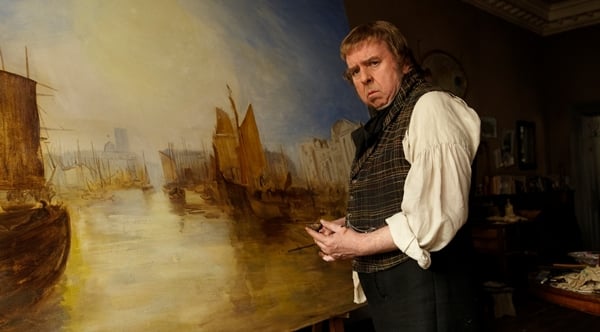
Photo via: artnet News
Film still of Mr. Turner (2014), by Mike Leigh.
Photo via: The Guardian
The short answer as to why filmmaker Mike Leigh tried for nearly 15 years to make a movie about J.M.W. Turner is that no one had done it yet.
It wasn’t until 1999, when the social-realist filmmaker made Topsy-Turvy, his first period piece, that he turned his attention to the irascible but brilliant artist as a subject. It was a difficult pitch, a movie about a man who grunts, scratches and occasionally humps his way through days when he’s not painting rhapsodic landscapes.
In the end, Leigh found the $13 million and cast longtime collaborator Timothy Spall as Turner. Spall, who won Best Actor at Cannes earlier this year and is on many critics’ best actor list, has hit a career high with Mr. Turner. In the process, he’s come to the conclusion that maybe acting and painting aren’t so different.
“I would never deign to believe that acting is as brilliant or as pure a form as painting, but I think Turner, as he was getting older, was getting to the very essence of things without having to worry about the form of them. You’re painting what you see,” says Spall. “To a certain degree it would be overpraising acting but I think there are parallels. You do feel you need to do less. It doesn’t mean you don’t have to think as much or work as hard. In a sense you have to work harder to do less.”
For Mr. Turner actor and director worked in Leigh’s customary way, building the character from the inside out. Beginning with no script, they used just the bare knowledge they have of the character and built outward through behavior and dialogue.
Oh, and Spall spent two years learning to paint.
“It imbues you and liberates you to be able to stand there whilst you’re building up this character and hold a brush,” he says. “What we were trying to do was make him look like he was a man born with a paintbrush in his hand and palette in the other—it’s about authenticity.”
Mr. Turner covers the second half of Turner’s life, when he was successful painter, favored by the Royal Academy, and a bachelor dogged by his previous wife and daughters, whom he disavowed. He lived with his devoted father, a former shopkeeper who assisted him, and his eczema-ridden maid whom, in the movie, he takes sexual advantage of.
J.M.W. Turner’s The City of Utrecht, 64, Going to Sea, right, and John Constable’s The Opening of Waterloo Bridge, left, at Tate in 2009.
Photo courtesy: The Daily Mail.
Memorable scenes include a famous incident which took place at the Academy in 1832 on Varnishing Day, when the artists put the final touches on their work. Finding his painting hung next to Constable’s larger and more dazzling The Opening of Waterloo Bridge (1829–31), Turner lands a blob of red paint in the middle of his own moody seascape, The City of Utrecht, 64, Going to Sea (also known as Helvoetsluys) (1832), drawing gasps from Academy members. Moments later, he shapes the vermilion blob into a buoy, vastly enriching his composition.
In his waning years, he spent more and more time in the seaside town of Margate, where he settled with an innkeeper and painted masterpieces like Snow Storm – Steam Boat off a Harbor’s Mouth in 1842 (the complete title is Snow Storm – Steam Boat off a Harbor’s Mouth Making Signals in Shallow Water, and Going by the Lead. The Author was in this Storm on the Night the Ariel Left Harwich), a proto-expressionist painting that predates the genre by 70 years.
“Turner always painted what he felt, as well as what he saw. So what he paints toward the end of his life is the embodiment of his life’s work,” Spall says. “Right at the point where he’s the most celebrated artist of his time, he sets out to start painting work that isn’t understood, that makes people think that he’s gone insane, that he’s gone blind.”
As depicted in the movie, the public, and even Queen Victoria, turns against him. Critic John Ruskin, who is portrayed as a spoiled little mama’s boy, really has it out for him.
“Our characterization of Ruskin comes from the research,” claims Leigh. “He was a spoiled babe brought up by these cossetting parents. When he went to university, his mother actually took rooms next door to his college so I think she could carry on breastfeeding him. We dramatized a precocious young, self-opinionated prick, which I think he was.”
Leigh and his crew also dramatized many of Turner’s compositional elements, such as the glowing smudge of a sun behind English clouds and the dun-colored, de-saturated palette of the artist. “What we set out to do was for the film to be informed by Turner’s palette,” Leigh says. “Even when we were in interiors, the colors and things were still very much of Turner’s palette.”
For more artnet News stories about Turner, see “artnet Asks: Mike Leigh, Director of New J.M.W. Turner Biopic” and “Timothy Spall Named Best Actor in J.M.W. Turner Biopic.”